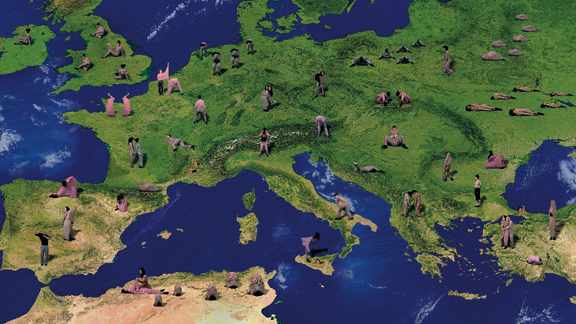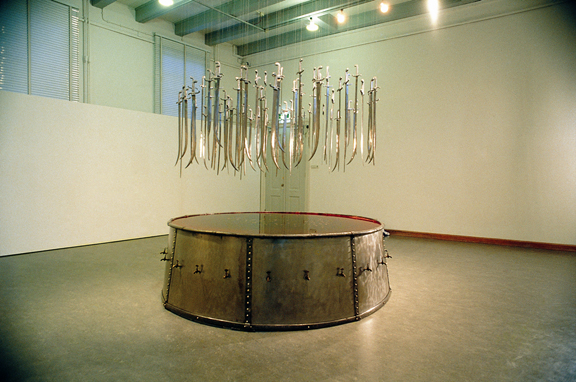Shows
“Dream and Reality: Modern and Contemporary Women Artists from Turkey,” Part Two


A link to the first half of this review can be found here.
From this point onward in the exhibition, viewers were cast off into an even less well-guided tour of artists born in the mid- and late-20th century, a story left largely untold by the many un-contextualized, mediocre paintings and facile installation pieces trafficking in clichés of womanhood, such as the acrylic paintings (made between 2003–06), by Nur Koçak (b. 1941), “one of the pioneers of photorealism in Turkey,” showing the many facial expressions of actress and director Cahide Sonku, and Azade Köker’s (b. 1949) delicate, newly produced, paper sculptures in the shape of wedding dresses or stockings. Worse still was Kezban Arca Batıbeki’s (b. 1956) installation Cage Project 2: Where To? (2002), an actual gold-painted cage that contains a classist parody of the contents of a working-class Turkish living room, with over-stuffed animal-print furniture, menthol cigarettes, images of pop stars from magazines and kitsch objects galore.
There were certain elegant works in the show. The inclusion of Abstract (Transience . . . Water . . . Sun) (1953), a lattice of red and yellow shapes across a 4.5-meter-long horizontal canvas, by Paris-based Fahrelnissa Zeid (1901–91), gave a proper sense of both what an artist was doing at her prime and the evident merits of her work compared with her male, and European, peers. The Silent Ones (1987), made for the first Istanbul Biennial that same year, by Candeğer Furtun (b. 1936), consists of ten nearly identical, white-ceramic abstract pieces whose shapes suggest a woman’s back, shoulder and head. This too was formally elegant and of its time.
Yet on the whole, one wondered throughout how knowledgeable or sensitive curators were to feminist art-history discourse. Alev Ebüzziya Siesbye (b. 1938) is a very good ceramicist, and the large bowls on view were ample evidence of this. But would an exhibition of male Turkish artists have included handcrafted domestic objects? If not, this betrays an old double-standard that reinforces the association of women with craft, and men with fine art.
The conceptual depth of the works improved in the latter part of the show, in part because curators moved away from presenting so many portraits or depictions of women and womanhood—which, as in Füsun Onur’s case and most others’—had the effect of reducing their practice to exclusively feminine, or feminist, subjects. Turkey’s modernization and the many poorer families who are being left behind by far-reaching transformations are captured in Nilbar Güres’ (b. 1977) “Çırçır” (2010) series of large, vertical photographs of domestic scenarios incongruously situated in landscapes undergoing massive infrastructural development. İnci Eviner’s (b. 1956) video Fluxes of Girls on Europe (2010) is a three-minute loop that shows a map of the European continent (Turkey included) dotted by pairs of figures resembling conjoined twins in customized bodysuits as they enact funny, repetitive motions—which make about as much sense as the gyrations that both the European Union and Turkey’s government do to keep up appearances about Turkey’s eventual membership in the European Union.
Hale Tenger’s (b. 1960) inclusion was impossible to miss: The School of Sıkımden Aşşa Kasımpaşa (I don’t give a fuck anymore) (1990)—Istanbul Modern elided the profane part of the work’s title from its press materials and wall text—was a giant metal cauldron filled with red-dyed liquid, above which are suspended dozens of Ottoman-era scimitars. While the piece refers to the still-unsolved 1990 assassination of academic and women’s rights activist Bahriye Üçok for publicly airing her views that Turkish women were not obligated to dress according to Islamic codes, it was also a welcome critique of Turkey’s creeping neo-Ottoman tendencies—all the rage these days in areas from cuisine to politics, social mores and religion.

In spite of a few happy exceptions along the way, “Dream and Reality” ended as disastrously as it began, with more apparently unintended curatorial messages. The final few works in the main exhibition hall were the colorful wire abstractions of Gülay Semercioğlu (b. 1968) whose forms, in these selected works in particular, were obviously vaginal-looking; Selma Gürbüz (b. 1960)’s two half-spheres assembled from semi-realistic plastic breasts, Kibele (2008); fleshy-looking latex wall-pieces and phallic-looking, cactus-like tabletop sculptures adorned with sprouts of actual hair by Ekin Saçlıoğlu (b. 1979); and Ebru Özseçen’s video Jawbreaker (2008), showing the artist sucking on a large piece of candy. That the curators concluded a show about female artists with several and sex-themed artworks either in the shape of reproductive organs or sexually themed seemed hopelessly myopic and retrograde, if not downright offensive—particularly following a series of more politically oriented works in which women were addressing Turkey’s national identity at large. Whatever the curators’ intended motivation for this conclusion, the sexist perspective on women’s destiny, or “reality”—uncannily foreshadowed by Erkmen’s piece at the beginning of the show—seemed to have won out by the end.
If “Dream and Reality” was meant to be a corrective to the generally neglected position of women in the arts (and Turkish society at large) since the late 19th-century, it neither conveyed a sense of their relationships to one another (aside from the kinship between several artists mentioned in wall texts) or to Turkey’s art community at large. How influential many of these modern artists in fact were was impossible to gauge.
The exhibition was also largely a self-serving one for the museum, as so few of these artists (with notable exceptions, such as Fahrelnissa Zeid, Hale Tenger, Ayşe Erkmen, Gülsün Karamustafa, İnci Eviner and a handful of younger artists) are on view in the Istanbul Modern’s permanent collection upstairs. Will the museum alter the display of its collection to more fully reflect and explain the reality of the important contributions made by women to Turkey’s modern and contemporary art history? Or will this too fade like a dream now that the show has closed?
“Dream and Reality” will only redeem itself, and have a real, lasting and positive impact in Turkey—rather than, in the ways outlined above, reinforcing female artists’ position as a marginal historical subject—if, in future, it comes to serve as the starting point for proper scholarship and adequate curatorial work on the artists brought to light here.







